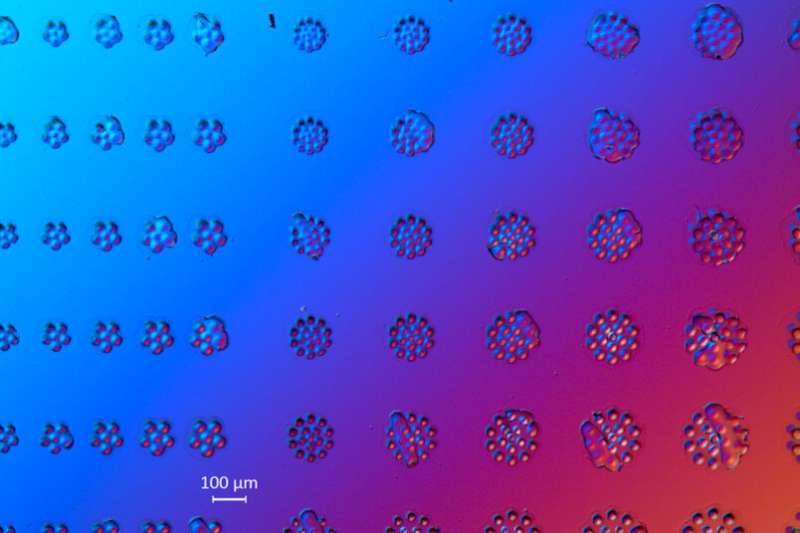This article has been reviewed according to Science X's editorial process and policies. Editors have highlighted the following attributes while ensuring the content's credibility:
fact-checked
peer-reviewed publication
trusted source
proofread
Tens of thousands of potential catalysts in the diameter of a single hair

When searching for catalysts for the energy transition, materials consisting of at least five elements are considered highly promising. But there are theoretically millions of them—how do we identify the most powerful one?
A Bochum-based research team led by Professor Alfred Ludwig, head of the Materials Discovery and Interfaces Department (MDI), has succeeded in placing all possible combinations of five elements on a carrier in a single step. In addition, the researchers developed a method to analyze the electrocatalytic potential of each of the combinations in this micromaterial library in high throughput.
This is how they hope to speed up the search for potential catalysts by a considerable degree. The team from Ruhr University Bochum published its findings in the journal Advanced Materials.
A complete five-element material system on a single carrier
For the production of material libraries of so-called high entropy alloys, the Bochum researchers employ a sputtering process. In this process, all of the starting materials are simultaneously applied to a carrier from different directions.
The starting materials are deposited in different mixing ratios on each part of the carrier. "In the current project, we've refined this process by using pinholes in such a way that each material mixture is only deposited in a tiny spot of about 100 micrometers in diameter on the carrier," says Alfred Ludwig. This is roughly equivalent to the diameter of a human hair.
"By miniaturizing the material libraries, we are now able to accommodate a complete five-component system on a single carrier—this constitutes immense progress," says Dr. Lars Banko from the MDI Department.
Research with hanging drops
To study the materials created with this technique, the researchers use what is known as scanning electrochemical cell microscopy (SECCM). This involves measuring the electrochemical properties of the material at a specific point via a hanging nanodroplet of an electrolyte measuring one thousandth the diameter of a hair.
"This means we can use high-throughput methods to pinpoint the candidates with the highest catalytic activity, where a more detailed analysis seems worthwhile," says Professor Wolfgang Schuhmann, head of the Department of Analytical Chemistry at Ruhr University Bochum.
Using these methods, the researchers are hoping to efficiently search through the plethora of possible materials for new catalysts in order to identify candidates that are particularly active as catalysts. Catalysts are needed, for example, for energy conversion processes that could enable us to use green hydrogen on a large scale as an environmentally friendly energy carrier.
More information: Lars Banko et al, Microscale Combinatorial Libraries for the Discovery of High‐Entropy Materials, Advanced Materials (2022). DOI: 10.1002/adma.202207635
Journal information: Advanced Materials
Provided by Ruhr-Universitaet-Bochum



















